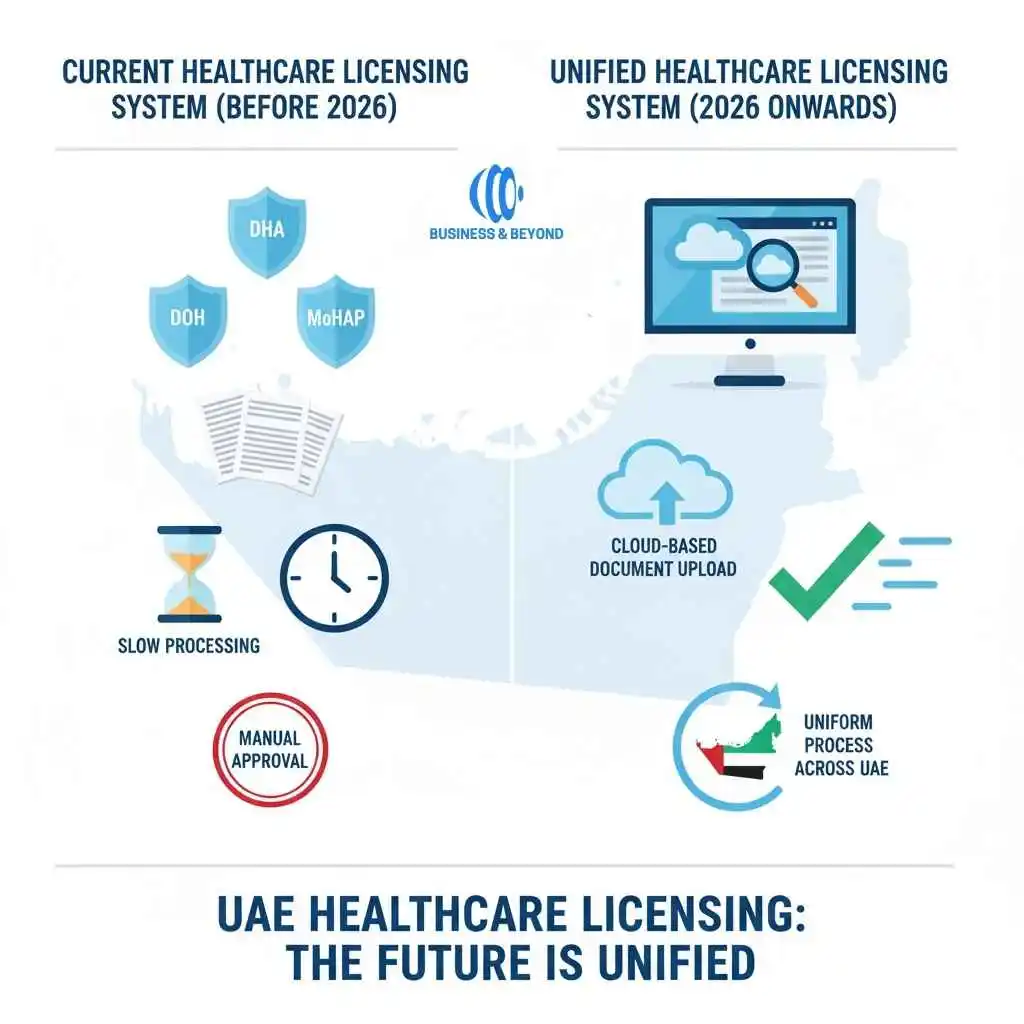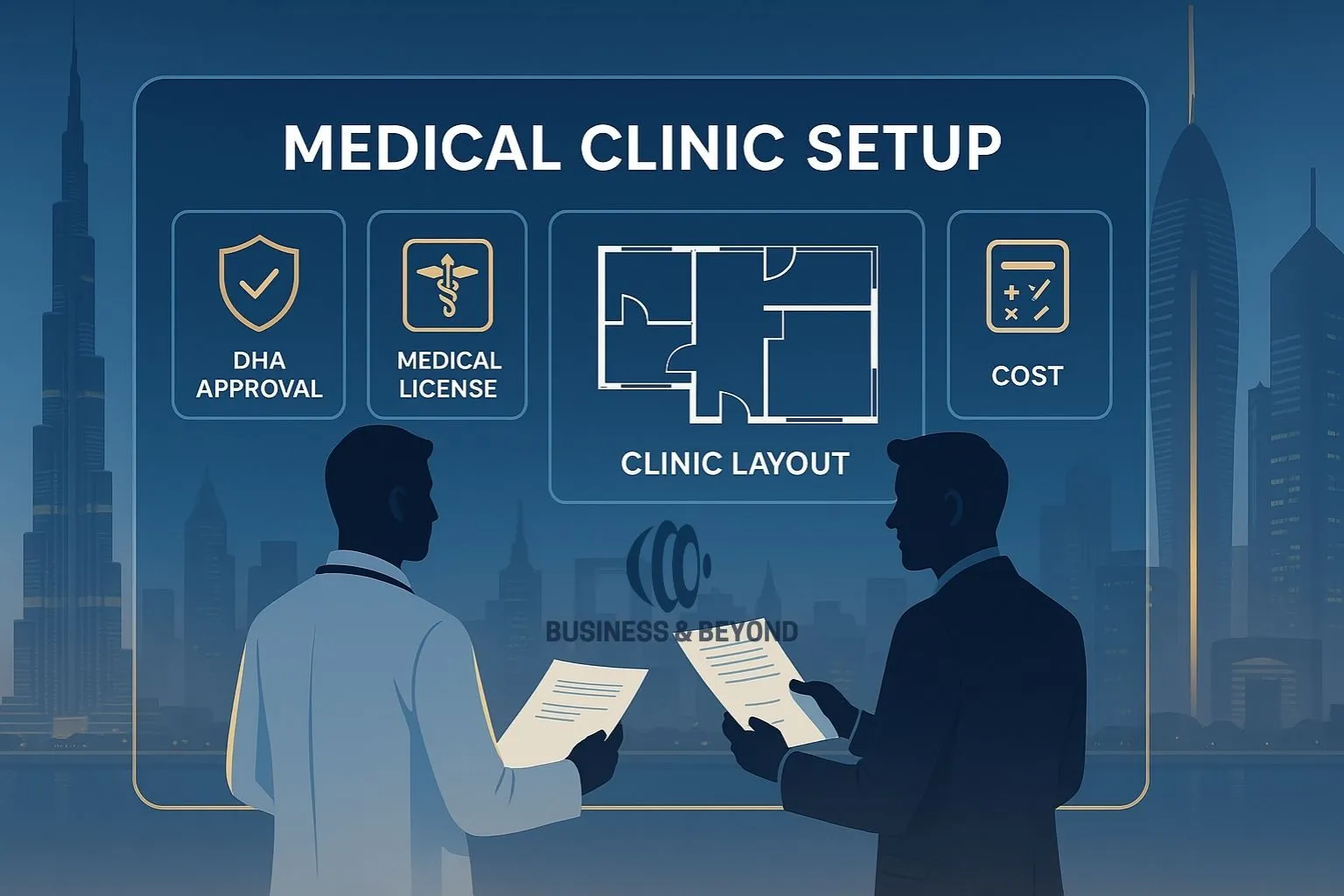
Starting and scaling a healthcare-related business in the UAE is rewarding, but also comes with heavy compliance responsibilities. From staffing and equipment supply to pharma distribution and corporate healthcare services, companies must stay on top of licensing and regulatory updates to operate legally.
The most significant change on the horizon is the Unified Healthcare Licensing System, set to launch in 2026, which will transform how B2B medical firms in the UAE are regulated. For businesses that supply, recruit, or service the healthcare industry, early preparation is no longer optional—it’s essential.
This guide provides a complete roadmap to help B2B medical firms understand the reform, plan ahead, and ensure smooth compliance before the new system goes live.
What is Unified Healthcare Licensing in the UAE?
The Ministry of Health and Prevention (MoHAP), alongside local health authorities like DHA (Dubai Health Authority) and DOH (Department of Health – Abu Dhabi), has announced the rollout of a single digital licensing platform.
Currently, licensing is fragmented across emirates, with different approval processes, documentation formats, and timelines. From 2026 onwards, firms will use one unified national system for all licensing activities.
This will bring:
- Standardisation – Uniform rules across all emirates
- Faster processing – Centralised approvals reduce wait times
- Stricter monitoring – Digital submissions leave no room for incomplete or outdated records

Who Will Be Affected? (Impact by Industry Segment)
The reform impacts all businesses operating within or serving the healthcare sector, particularly:
- Medical equipment suppliers – Must align product certifications and licenses to centralised requirements.
- Healthcare staffing & outsourcing firms – Credentials of doctors, nurses, and technicians will undergo unified verification.
- Pharma distributors & logistics providers – Standardised procedures for drug approvals and movement across emirates.
- Corporate healthcare providers – Licensing for B2B service delivery, from IT systems to wellness management, will be centralised.
Bottom line: Any B2B firm that supplies, supports, or partners with healthcare providers must prepare for this reform.
Unified Licensing vs Current Licensing – What Changes?
| Aspect | Current System (Pre-2026) | Unified System (2026 Onwards) |
|---|---|---|
| Approval Authorities | Different per emirate (DHA, DOH, MoHAP) | Single digital platform (MoHAP-led) |
| Document Submission | Varies – physical + digital | Fully digital, centralised |
| Processing Time | Weeks to months | Expected to be faster but stricter |
| Compliance Monitoring | Manual exceptions possible | Automated, immediate detection |
Roadmap to 2026: How B2B Firms Should Prepare
The transition to a unified licensing environment requires systematic planning. Below is a practical step-by-step roadmap:
Step 1 – Audit Existing Licenses
- Verify current practitioner credentials, product approvals, and business licenses.
- Identify gaps where documents may not align with centralised standards.
Step 2 – Digitise All Compliance Records
- Move paper-based records into secure, searchable digital formats.
- Ensure files are labelled, dated, and backed up for easy submission.
Step 3 – Train HR & Compliance Teams
- Staff onboarding processes must match MoHAP verification standards.
- Invest in compliance training workshops to prepare teams for digital submissions.
Step 4 – Implement Compliance Software & Dashboards
- Automated alerts for renewals and expiry dates.
- Real-time dashboards for tracking submissions and approvals.
Step 5 – Run a Mock Submission Before 2026
- Test your readiness by simulating a submission.
- Identify weak points and resolve them before the real rollout.
Compliance Costs & Resource Planning
Preparing for the new system requires upfront investment. Key areas to budget for include:
- Software & digital transformation – Compliance management tools, secure document storage.
- Training & HR resources – Workshops, regulatory updates, and internal audits.
- Consultancy & legal fees – Expert advisors to review compliance readiness.
Tip: Early preparation reduces the risk of costly delays or rejected applications, which can disrupt contracts and cash flow.
Risks of Delaying Preparation
Companies that wait until 2026 may face:
- Contract disruptions – Inability to supply or staff healthcare providers due to pending approvals.
- Financial penalties – Non-compliance could lead to fines or lost business opportunities.
- Reputation risks – Healthcare is highly regulated; a single licensing error damages client trust.
Benefits of Early Alignment
On the positive side, firms that act now gain:
- Faster approvals across all emirates once the system goes live.
- Competitive advantage – Early adopters will service clients more reliably.
- Scalability – Easier to expand operations across the UAE with one unified license.
Case Study: Preparing Ahead
Imagine a medical equipment supplier that began preparations in 2024. By auditing licenses, digitising all compliance records, and training its HR team, the firm was fully aligned when the system launched in 2026.
Outcome:
- Zero downtime in approvals
- Smooth onboarding of staff
- Ability to expand into Abu Dhabi and Sharjah seamlessly
Lesson: Proactive preparation secures long-term growth and regulatory peace of mind.
Compliance Readiness Checklist (Downloadable Magnet)
✅ Audit practitioner and business licenses
✅ Digitise and back up compliance documents
✅ Train HR and compliance staff
✅ Adopt compliance management software
✅ Test mock submissions before 2026
👉 CTA: Download our free “Healthcare Licensing Readiness Checklist” to see if your firm is prepared.
How Business & Beyond Can Help
At Business & Beyond Consulting LLC FZ, we support B2B medical firms in navigating complex UAE regulations. Our services include:
- Tailored compliance roadmaps
- End-to-end document preparation
- Training workshops for internal teams
- Advisory on MoHAP updates
📩 Contact us today to secure your compliance readiness before 2026.





Leave A Comment